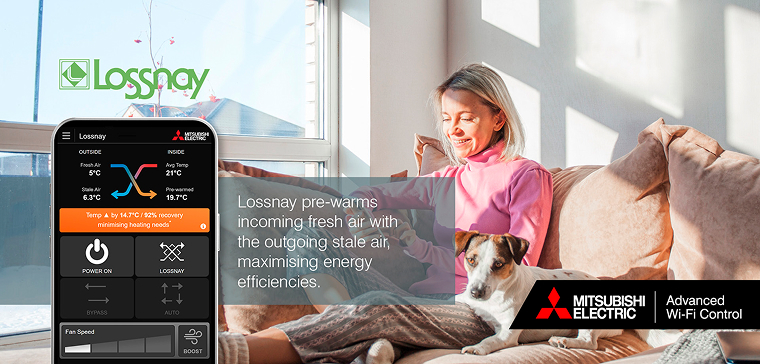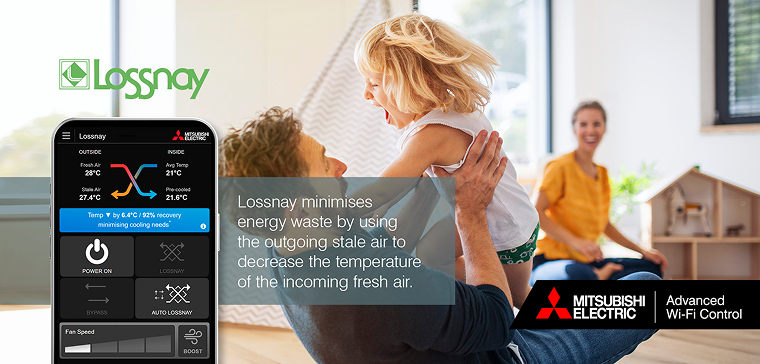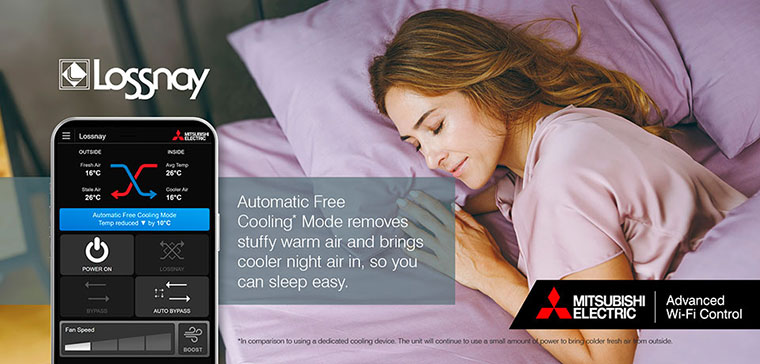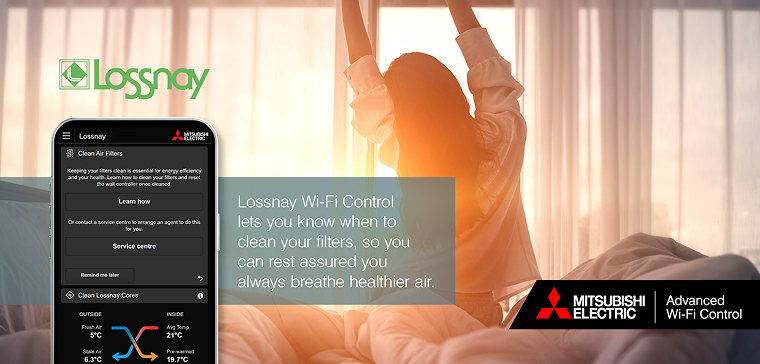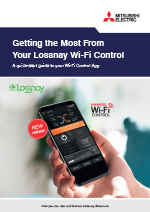Lossnay Wi-Fi Control
Fresh Air Heat Recovery Ventilation
Now You Can See and Feel the Lossnay Difference
Elevating air quality and maximising energy efficiencies has never been easier, because now the power is in your hands.
Lossnay Wi-Fi Control shows you by how many degrees Lossnay is pre-warming or pre-cooling incoming fresh air in real‑time. This feature helps you save on your power bill because less additional heating or cooling is required to bring the fresh air introduced to your home up to an ideal temperature.
In summer you can monitor by how many degrees Lossnay reduces your home’s temperature, using Automatic Free Cooling^ Mode.
The App will also proactively remind you when it is time to clean your filters, maximising both cost‑efficient operation and health benefits.
Lossnay Wi-Fi Control truly is the smart evolution in fresh air ventilation. This comes standard with the Vertical Lossnay Series*, and as an option for the LGH Ranges.
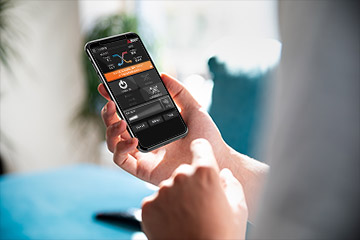
^In comparison to using a dedicated cooling device. The unit will continue to use a small amount of power to bring colder fresh air from outside.
*Wi-Fi interface included from January 2024.

See How Much Energy is Recovered From the Outgoing Stale Air
The App displays the real‑time percentage of heat recovered.
Rather than going to waste, Lossnay's unique Heat Recovery Technology recovers up to 92%* of the heat energy in the outgoing air, which is then used to pre‑warm or pre-cool the incoming fresh air.
In doing so, moisture build‑up in your home is minimised, while healthy humidity levels are maintained and managed in the most energy efficient way possible.
- In this example, an average of 92% heat recovery is achieved at low fan speed.
- The incoming fresh air is pre-warmed by 14.7°C using the heat from the outgoing stale air.
- As a result, the incoming supply air temperature is raised to 19.7°C.
- If the desired indoor room temperature is 21°C, the primary heat source will only need to increase the fresh air temperature by 1.3°C.
*VL-500 on lowest fan speed and based on winter conditions.


Pre-Warming: See by How Many Degrees Lossnay Increases the Average Temperature
The App shows by how many degrees the unique Lossnay Core is able to pre‑warm the incoming fresh air when it crosses over with the outgoing stale air.
Because of the unique Lossnay Core, additional heating of the incoming fresh air in winter is reduced, maximising energy efficiencies.
- In this example, the outside air temperature is 5°C.
- The colder incoming fresh air is increased by 14.7°C.
- If the desired indoor room temperature is 21°C, the primary heat source will only need to increase the fresh air temperature by 1.3°C.


Pre-Cooling: See by How Many Degrees Lossnay Decreases the Average Temperature
In summer, the App shows by how many degrees the unique Lossnay Core is able to pre-cool the incoming fresh air when it crosses over with the outgoing stale air.
Because of the unique Lossnay Core, if you are using an air conditioner at the same time, the outgoing stale air will be used to pre-cool the incoming fresh air.
As a result, it will take less additional energy to cool to the desired set temperature, maximising energy efficiencies.
- In this example, the outside air temperature is 28°C.
- The air is filtered and drawn through the unique Lossnay Core, where it crosses over with the air conditioned indoor air at 21°C.
- As a result, the warmer incoming fresh air is decreased by 6.4°C.
- If the desired indoor room temperature is 21°C, the primary cooling source will only need to decrease the fresh air temperature by 0.6°C.
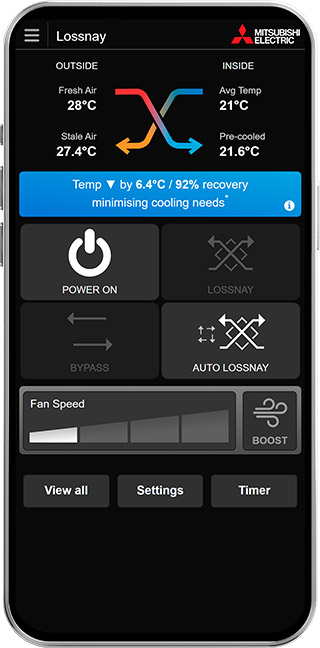

Automatic Free Cooling^ Mode in Summer
When Auto Mode is activated, Lossnay’s onboard temperature sensors will automatically enter Auto Bypass Mode when the outside air is cooler than the desired set temperature inside the home.
As a result, cooler fresh air is introduced and stale air is extracted, bypassing the Lossnay Core. This is ideal for cooling down a dwelling that may have overheated during the day, once the outside temperature has dropped in the evening.
- In this example, the outside night time temperature of the air is 16°C.
- The indoor temperature is 26°C.
- As this is warmer than the incoming fresh air, the Lossnay Core is automatically bypassed by the return air streams, and 16°C fresh air is supplied directly.
- As a result, the indoor temperature can be reduced by 10°C, unless a set point temperature is met.
^In comparison to using a dedicated cooling device. The unit will continue to use a small amount of power to bring colder fresh air from outside.
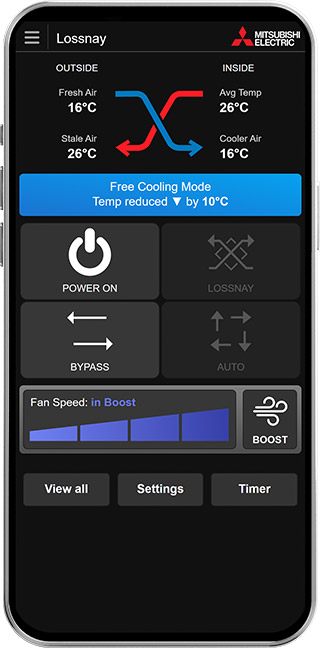
Cool down even faster by activating Boost Mode, optimising how quickly the cooler, fresh, outdoor air is introduced. This setting increases the fan speed to maximum for 15 minutes before returning to your original fan speed.

Automatic Filter and Core Cleaning Reminders
A dirty filter or Lossnay Core will force the Lossnay system to work harder, impacting energy efficient operation.
The Lossnay Wi-Fi Control App takes the guesswork out by proactively notifying you when it is time to clean both the filters and the core.*
- In this example, the cleaning notification automatically pops up at the top of the screen.
- This is linked to an easy to follow video and a written step-by-step guide that will walk you through how you can do this yourself.
- Alternatively, the App can also connect up with your installer or local service centre if you would like this done by a professional.
Example information on cleaning a Lossnay VL-500:
Learn how to clean the Filters
Learn how to clean the Lossnay Core
*Filter and core cleaning notifications are based on suggested system run time.
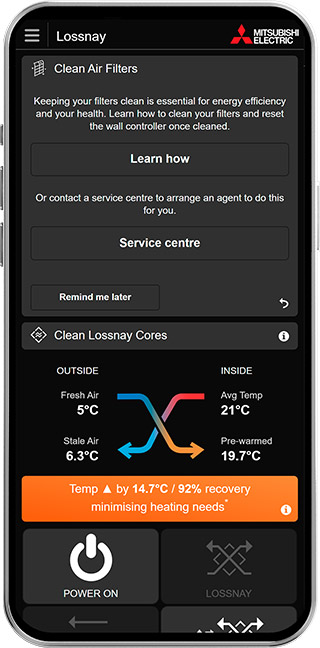

Optional CO2 Monitoring
The Lossnay RVS and RVX3 Models have the option of an additional CO2 sensor. When connected with the optional Wi-Fi Control Adapter, CO2 levels can be viewed in real-time making it ideal for schools, medical facilities and offices.
It is well known that poor air quality impacts health, wellbeing and concentration levels. In conjunction with the CO2 sensor, the Lossnay RVS and RVX3 systems intuitively adjust airflow to ensure optimum air quality, no matter how many people are in the room.
The Auto Fan Mode will activate when moderate or high levels of CO2 are detected. Once CO2 levels are back to normal, the system will revert back to the original fan speed.
- In this example, the CO2 level is currently high.
- When Auto Fan Mode is activated the system will override the set fan speed, adjusting to the highest fan speed.
- The system will continuously adjust the maximum volume of fresh air changes until optimum CO2 levels are reached.




Optional Wi-Fi Interlock* for Total Home Control
Seamlessly combine your Mitsubishi Electric Ducted Heat Pump and Lossnay Energy Recovery Ventilation System through your Wi-Fi Control App for ultimate visibility and control.
Because your Ducted Heat Pump needs to be in fan, heating or cooling mode for the connected Lossnay system to operate, you can now choose from two innovative modes to customise your climate control setup.
Use the "Power Interlock" mode, to enjoy set and forget convenience.
In this mode both systems will always automatically activate together no matter which system you initially turn on.
Opt for "Fresh Air Fan Interlock" mode to prioritise fresh air circulation; regardless of whether the ducted system is turned on.
In this mode, the Lossnay System will override a ducted system that is turned off and automatically activates the system’s Fan Mode. As a result, fresh air continues to circulate efficiently throughout the home.
*Note: To enable Wi-Fi Interlock Control, both units will require a Wi-Fi Interface.
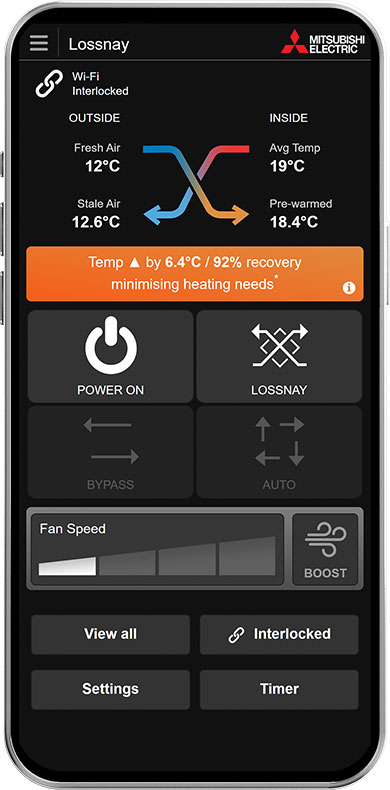


Try the Demo Today!
Lossnay Wi-Fi Control makes the invisible, visible. Try the interactive Lossnay Wi-Fi Control demo so you can see all the benefits that Lossnay can offer you and your family from the one App.
- Lossnay Wi-Fi Control comes standard with the Vertical Lossnay Range.
- The RVS and RVX Series require an optional Lossnay Wi‑Fi Control adapter to access these advanced features.
- CO2 Monitoring is only available as an optional extra on the RVS and RVX3 ranges and requires an additional CO2 sensor.
Wi-Fi Interface
Looking for a new Lossnay System including Wi-Fi?
The Wi-Fi Interface is available on selected Mitsubishi Electric Lossnay units, and can either be purchased as an optional upgrade when purchasing a new Lossnay system, or retrofitted to an existing model.
Looking to upgrade your existing Lossnay System with the addition of the Wi-Fi Interface?
Support
Downloads
 How to Use - Wi-Fi Lossnay Control.pdf (3,670 KB)
How to Use - Wi-Fi Lossnay Control.pdf (3,670 KB) User Manual - Wi-Fi Control Service.pdf (2,769 KB)
User Manual - Wi-Fi Control Service.pdf (2,769 KB) Brochure - Wi-Fi Lossnay Control.pdf (1,328 KB)
Brochure - Wi-Fi Lossnay Control.pdf (1,328 KB)
MAC-588IF-E:
 Quick Reference Setup Guide - Wi-Fi Interface.pdf (999 KB)
Quick Reference Setup Guide - Wi-Fi Interface.pdf (999 KB) Installation Guide - Wi-Fi Interface.pdf (1,085 KB)
Installation Guide - Wi-Fi Interface.pdf (1,085 KB)
Support
Requirements
Download App
Download from
The Wi-Fi Control application can only be downloaded from the New Zealand and Australian Apple App Store or Google Play store.
Just search for “Mitsubishi Wi-Fi Control” or follow these direct links:
Apple and the Apple logo are trademarks of Apple Inc., registered in the U.S. and other countries. App Store is a service mark of Apple Inc.
Try the Demo
Wi-Fi Lossnay Control Demo
With the Lossnay Wi-Fi Control App, you can see and feel the Lossnay Heat Recovery Ventilation difference.
Some of the features of the App include;
- Indicative Recovery Savings (pre-warm or pre-cool)
- Automatic Free Cooling^ Mode
- Filter and Core Cleaning Reminders
- Timer and Fan Settings
- Monitor CO2 Levels*
In this Lossnay WiFi Control App demo, you can see by how many degrees† the unique Lossnay Core is able to pre-warm or cool the incoming fresh air in real-time. Because of the unique Lossnay Core, additional heating or cooling of the incoming air is reduced, maximising energy efficiencies.
- In this demo example, we are using a VL500 and the outside air temperature is 12°C.
- The colder incoming fresh air is increased by 6.4°C.
- If the desired indoor room temperature is 19°C, the primary heat source will only need to increase the fresh air temperature by 0.6°C.
*Note: Monitor CO2 Levels is only available when an extra sensor is fitted to LGH~RVS or LGH~RVX3 Models.
†The outside ‘Fresh Air’ and the inside ‘Avg Temp’ air temperatures are measured by the built-in sensors that are centrally located in the main Lossnay Ventilation unit.
^In comparison to using a dedicated cooling device. The unit will continue to use a small amount of power to bring colder fresh air from outside.

